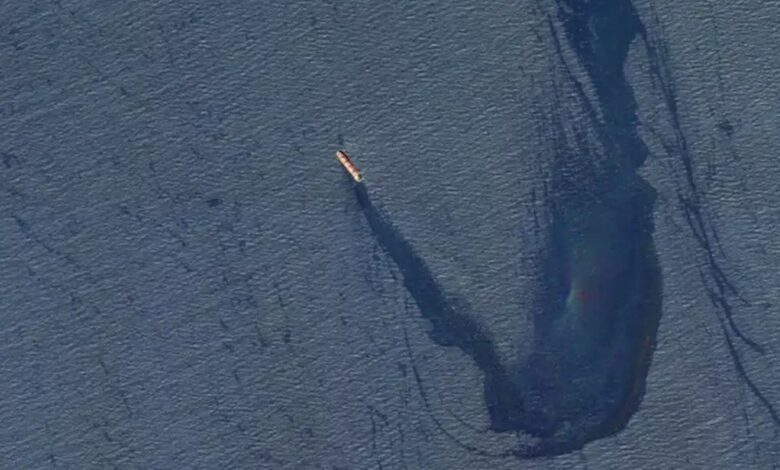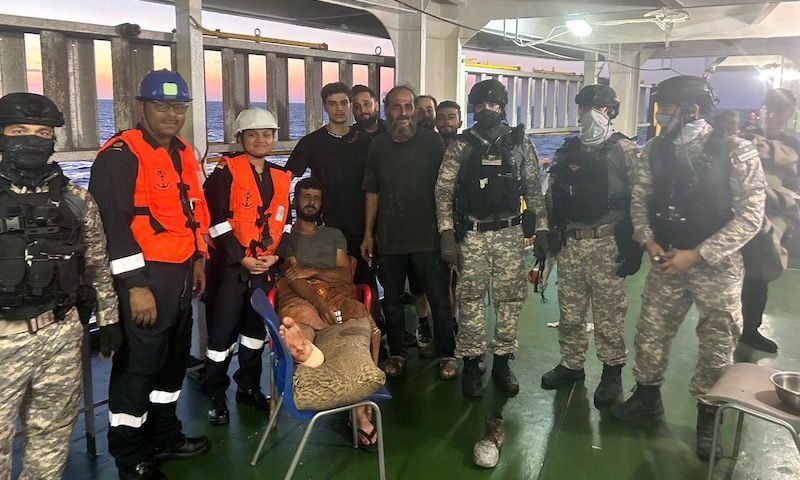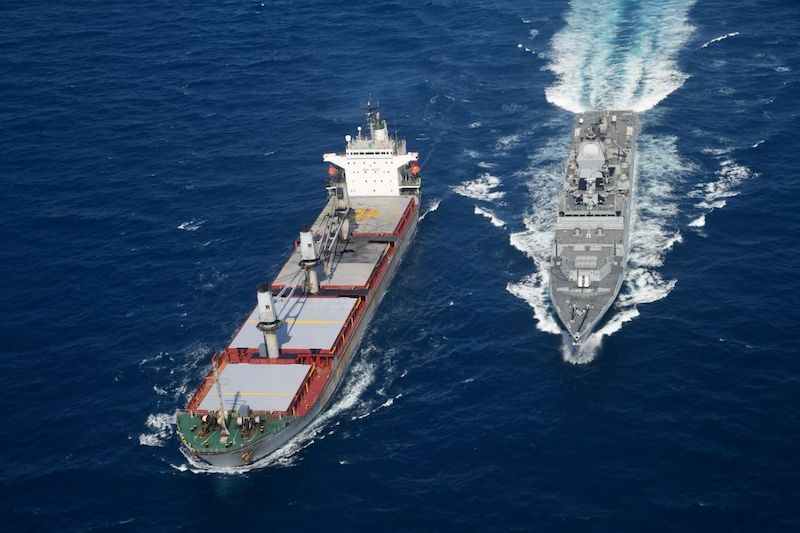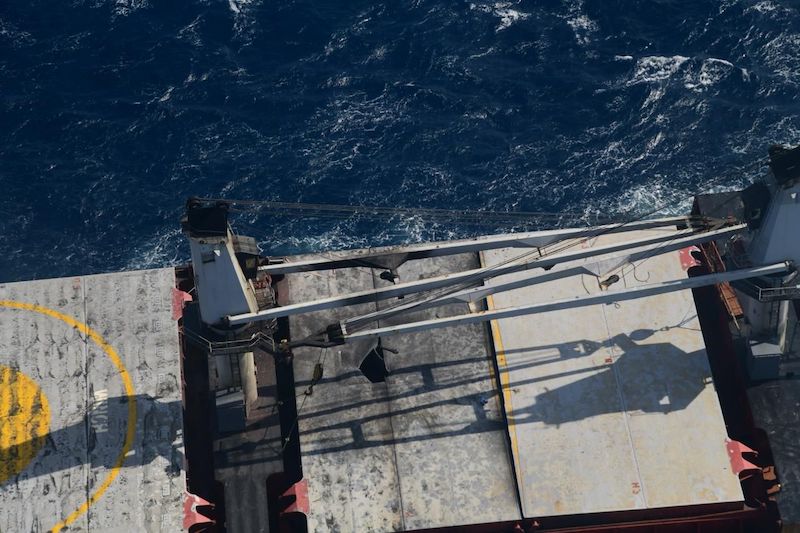Images emerge from Houthi escalation of attacks on shipping

The missile attack by Houthi militants on the Rubymar, a ship carrying a cargo of fertilizer, has led to an “environmental disaster” in the Red Sea, US Central Command said Friday evening, while images have emerged of the first crew injury from the Houthi attacks.
The Indian Navy has released images of the aid it gave to the Palau-flagged Islander which caught fire after an attack on February 22 during which one crew member was injured – the first reported injury from the four months of attacks that have seen some 60 merchant ships targeted. The health of the crew of the Galaxy Leader, a car carrier captured and being held by the Houthis for more than three months, remains unclear.

Concern is growing that the Rubymar could sink. The ship has been taking on water and images show it is down at the stern, while satellite images show a growing 30 km long streak of bunker fuel seeping from the anchored ship.
The crew of the Belize-flagged Rubymar was forced to abandon the vessel on February 18, marking the first such evacuation since the Houthis began disrupting commercial shipping in the Red Sea in response to the war in the Gaza Strip. It is carrying around 41,000 tons of fertiliser.
On Saturday, the US-flagged Torm Thor was targeted by Houthis. An anti-ship ballistic missile aimed at the tanker was downed by the USS Mason destroyer.
American and British aircraft attacked multiple Houthi sites in Yemen over the weekend. Unbowed, the Houthi leadership vowed to escalate their attacks.
“The Yemeni Armed Forces affirm that they will confront the US-British escalation with more qualitative military operations against all hostile targets in the Red and Arabian Seas in defence of our country, our people and our nation,” the Houthi leadership said in a statement.
Data from Clarksons Research shows that as of last Friday tonnage transiting the Suez Canal was down 66% versus the first half of December, while tonnage passing the Cape of Good Hope was up 85%.
“Mounting uncertainty and shunning the Suez Canal to reroute around the Cape of Good Hope is having both an economic and environmental cost, also representing additional pressure on developing economies,” stated a new report from the United Nations Conference on Trade and Development (UNCTAD). UNCTAD estimates that thanks to increased vessel speeds to maintain schedules ships are using far more fuel, whereby for a Singapore to Rotterdam roundtrip greenhouse gas emissions could be up by as much as 70%.
Pictured below, the damage to the deck of the Palau-flagged general cargo ship Islander which was targeted with two missiles on Thursday morning off Aden.



If the oil washes up on Yemeni shores it will be a spectacular own goal and demonstrate just how imbecilic the perpetrators of the attacks are. And they think they are winning? .
The bravado of their press and media output is just laughable. At some point there will be a reckoning over this. Then we’ll hear the screaming.
Not forgetting that quite a few of the damaged ships were carrying cargos connected to Houthi friends.
41 K tons of fertilizer ??? .
Well I am not sure if it is :
a) 41 K tons
b) fertilizer.
Ad. a) what tons? seems a valid question as her Summer Deadweight (t) is 32211. Source : ais trackig websites and Wiki . Substract bunkers, FW, luboils, stores and constant and possibly some ballast as some sources claim she was not fully laden and there is no way to arrive at 41 K Mt . Try short tons conversion and it is still >> then 32211.
Ad. b) Maritime Executive and other news joints are screaming about ” explosive cargo” on board . Examination of IMSBC CODE 2020 Ed pages 90-101 reveal much more sinister possibility of what can be considered as ” explosive cargo” .
With 22000 Mt of Ammonia nitrate , there is no wonder crew evacuated the ship asap. Very wise decision in such circumstances.
But I may be wrong of course.
” the Rubymar, a ship carrying a cargo of fertilizer, ” The photographs indicate she had very little cargo, if any. So, an added twist to the Lebanese tale.
What photographs do You have in mind and idicate the source please. Done by whom ??: surveyors, prof. journalists, tourists or provocateurs.
Doctored with AI or other smart gadgets or with original metadata and not tampered with? I am just curious. Have never judged the amount of cargo by photographs but by drafts . Show me or guide me to photograph showing forward and midship draft prior E/R flooding and with Mr. Bryan Barrass guidance I will tell You abt cargo.
“What photographs do You have in mind ” The ones all over the media, including Plash24/7.
Must admit You Sir are keeping me intrigued with your firm conviction she has no cargo or “little cargo if any” .
Readers of Trade Winds paying prohibitive sums for subscription , which I can not afford must be hugely dissapointed then , as it is there where 22 K T of fertilizer is coming from. However I have pulled from brokers selling ships two almost similar re. DWT handy bulkers close to the year of built of Rubymare .
Both have almost identical dimensions LOA/Lpp and B. Their summer DWT draft is 0.6 m different though. I have also a detailed blue prints including stability/draft & loading conditions of a bulker of identical LOA/Lpp but B = 30 m , hence her max summer drafts are smaller then Ruby .
Have checked her ( with B=30m) light ballast conditions and heavy ballast conditions . Need to rethink and recheck the comparisons but given Ruby reported draft from Ais sources of 8.9 mtrs ( if it was true of course) , it is in my modest opinion ,highly unlikely, Ruby was empty , sailing under heavy ballast with Hold no.3 ballasted ( weather there was fine) but it is more likely she had partial /”little” cargo.
It is absolutely unlikely though ,she had 41 K t of cargo as reported by Splas247 .
In conclusion an average Joe had to trust somebody and option given by highly reputable Trade Winds is very highly likely. Unless You Sir have insider info from her dep port agents or arr. port agents or ship master is your drinking buddy.
But if your info is only from Splash247 photographs , then You are either pulling my leg 😉 or it is highly likely You are not serious.
I need to recalculate and rethink basis available data from other ships of similar size though , to be certain.
Trust editors will not close this thread too soon as I am really a slow thinker 😉 but revved up to explore the topic .
Cheers and have a wondeful rest of your day and night.
Further to my previous I have compared two ships of similar size from ship-broker.eu/tag/handysize -bulker/.
1. ) M/V SYDNEY / ABT 31,759 MDWT ON 10.42m DIMS 171,59 / 163,60 x 27 x 14,8 M/LDT abt 7,275 mt
2.)MV“VALOR”/DWT / DRAFT: 29818 MTS / 9.716 M/LOA / BEAM 170.70 / 27.00 M
3.) Basis item 1) have calculated TPC =34 t/cm basis Cb=0.75 .
Basis item 1,2,3 and hydrostatic data of known ship including precise calc/results of ballast conditions light and heavy , have calcultaed/estimated summer DWT draft of Rubymar at 10.40 mtr SW +/- 0.05.
What shall cheer You up, is that all this ” heavy duty delibertions ” 😉 were a waste of my time and effort as in Wiki I have found Rubymar summer DWT draft at precisely 10.40 .mtr 😉
Basis her reported AIS draft of 8.9 mtrs before the incident ( hope it was mean/midship draft and not max sailing draft ) she was (10.4-8.9) x 34×100 = 5100mt shy from her 32211 mt DWT . (27111 mt) .
Have estimated her ballast tk capacity by comparison with known vessel of similar size at abt 14000 mt. With added estimated weight of SWBW at hold no 3 ( heavy ballasting) of 6000-7000 mt , the leftover is still way too big for ROB fuels, lubs , FW, stores constant .
Hence i dare to claim she was not with ” little or no” cargo.
One thing is certain though. In her present condition she is only one watertight bulkhead away from going down.
Cheers and have a wonderful rest of your day and/or night .
P.S. Editors thx for your patience.
Another issue:
One of the careful readers of maritime news and dilligent follower of Splash247 stories observed as follows on gCaptain forum :
quote:
On Saturday, the US-flagged Torm Thor was targeted by Houthis. An anti-ship ballistic missile aimed at the tanker was downed by the USS Mason destroyer. ( Splash247)
She is obviously a very fast ship. According to Vesselfinder.com she left Djibouti 25.02 and is now at a yacht marina in Panama: TORM THOR, Chemical/Oil Products Tanker – Details and current position – IMO 9712292 – VesselFinder 2
And a bit of a mystery vessel.
Marinetraffic.com has her in South Korea and looking like a Catamaran:
Ship TORM THOR (Oil/Chemical Tanker) Registered in USA – Vessel details, Current position and Voyage information – IMO 9712292, MMSI 368118000, Call sign KTTL 2
end quote
Interesting that US flagged ships have the “warp” speed capabilities . I may be wrong of course.
” . I may be wrong of course.” Or your sources.
Sorry but it looks You Sir most probably did not catch my drift-I mean sarcasm.
But I may be wrong of course.
‘But I may be wrong of course.’ You may well be.